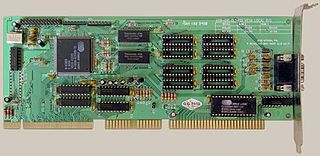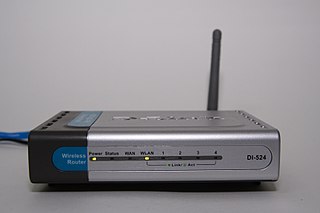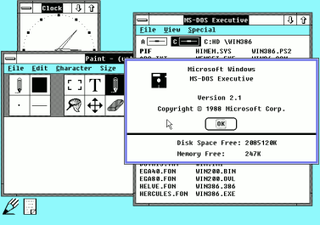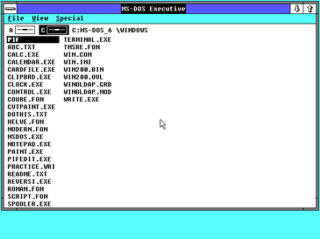Related Research Articles

On computers, a serial port is a serial communication interface through which information transfers in or out sequentially one bit at a time. This is in contrast to a parallel port, which communicates multiple bits simultaneously in parallel. Throughout most of the history of personal computers, data has been transferred through serial ports to devices such as modems, terminals, various peripherals, and directly between computers.

Super VGA (SVGA) is a broad term that covers a wide range of computer display standards that extended IBM's VGA specification.
Kerio Technologies, Inc. is a former technology company specializing in collaboration software and unified threat management for small and medium organizations. Founded in 2001, Kerio is headquartered in San Jose, California. In January 2017, GFI Software acquired Kerio. GFI Software is owned by Aurea SMB Solutions, which in turn is owned by ESW Capital Group.

Null modem is a communication method to directly connect two DTEs using an RS-232 serial cable. The name stems from the historical use of RS-232 cables to connect two teleprinter devices or two modems in order to communicate with one another; null modem communication refers to using a crossed-over RS-232 cable to connect the teleprinters directly to one another without the modems. It is also used to serially connect a computer to a printer, since both are DTE, and is known as a Printer Cable.
The Parallel Line Internet Protocol (PLIP) is a computer networking protocol for direct computer-to-computer communications using the parallel port normally used for connections to a printer.
Direct Cable Connection (DCC) is a feature of Microsoft Windows that allows a computer to transfer and share files with another computer, via a connection using either the serial port, parallel port or the infrared port of each computer. It is well-suited for computers that do not have an ethernet adapter installed, although DCC in Windows XP can be configured to use one if available.

A wireless router or Wi-Fi router is a device that performs the functions of a router and also includes the functions of a wireless access point. It is used to provide access to the Internet or a private computer network. Depending on the manufacturer and model, it can function in a wired local area network, in a wireless-only LAN, or in a mixed wired and wireless network.

Imaging for Windows from Global 360 is document imaging software. Earlier versions of Imaging for Windows were available for Windows 95-98/Me/NT/2000. Global360 Imaging for Windows is the upgrade to this Imaging software, which was discontinued as of Windows XP. Its image viewing, editing and scanning functions are superseded by Windows Picture and Fax Viewer and Microsoft Paint, both of which are based on GDI+ in Windows XP. However, the multi-page picture editing functions are gone with the Imaging software.

A serial cable is a cable used to transfer information between two devices using a serial communication protocol. The form of connectors depends on the particular serial port used. A cable wired for connecting two DTEs directly is known as a null modem cable.
Interactive Systems Corporation was a US-based software company and the first vendor of the Unix operating system outside AT&T, operating from Santa Monica, California. It was founded in 1977 by Peter G. Weiner, a RAND Corporation researcher who had previously founded the Yale University computer science department and had been the Ph.D. advisor to Brian Kernighan, one of Unix's developers at AT&T. Weiner was joined by Heinz Lycklama, also a veteran of AT&T and previously the author of a Version 6 Unix port to the LSI-11 computer.
LiveWire Professional is a MS-DOS program made by CableSoft. It was first introduced in 1988 as software/expansion board combination, which allowed to convert Financial News Network ticker from television receivers into ASCII for further analysis. The software is designed for stock brokers and financial analysts, allowing them to record and analyse the stock market, through the use of live feeds. However, its user interface was criticized as cumbersome.
Meeting Maker is a cross-platform personal calendar and group scheduling software application from PeopleCube. First released in 1991 for Macintosh by ON Technology, support for other platforms followed in 1993 with Meeting Maker XP. Alongside Windows and Mac, native clients were released for OS/2 and Solaris, and later also for other platforms. Some support was also introduced for mobile platforms like Apple Newton, PalmPilot and Windows CE. Although powerful, its user interface - aiming at uniformity across multiple platforms — was criticized as weak and not supporting all features of target platforms.
Xircom, Inc., was an American computer networking hardware and mobile technology company. Headquartered in Thousand Oaks, California, Xircom was one of the first companies to develop network computing products for notebook computers. Products included computer memory cards, LAN adapters, modems, and remote access server products. The company's products enabled notebook users to share information over a network connection.

Windows 2.1 is a major release of Microsoft Windows. It was released to manufacturing on May 27, 1988, as a successor to Windows 2.0.

Windows 2.0 is a major release of Microsoft Windows, a family of graphical operating systems for personal computers developed by Microsoft. It was released to manufacturing on December 9, 1987, as a successor to Windows 1.0.
A legacy-free PC is a type of personal computer that lacks a floppy or optical disc drive, legacy ports, and an Industry Standard Architecture (ISA) bus. According to Microsoft, "The basic goal for these requirements is that the operating system, devices, and end users cannot detect the presence of the following: ISA slots or devices; legacy floppy disk controller (FDC); and PS/2, serial, parallel, and game ports." The legacy ports are usually replaced with Universal Serial Bus (USB) ports. A USB adapter may be used if an older device must be connected to a PC lacking these ports. According to the 2001 edition of Microsoft's PC System Design Guide, a legacy-free PC must be able to boot from a USB device.
Commodore 64 disk/tape emulation and data transfer comprises hardware and software for Commodore 64 disk & tape emulation and for data transfer between either Commodore 64 (C64), Commodore (1541) disk drive or Commodore tape deck and newer computers.
PerfectDisk is a defragmentation software product for Windows developed by Raxco.

The IBM ThinkPad 365 is a notebook computer series developed by IBM and manufactured by ASE Group. It was released in North America in November 1995, and was the successor of the ThinkPad 360 series. The series had 8 models that were released before being discontinued, and was succeeded in 1997 by the ThinkPad 380 series.

The IBM ThinkPad 700 is the first notebook computer for the ThinkPad brand that was released by IBM on October 5, 1992. Another series was released alongside it, the ThinkPad 300 series. The 300 series was meant to be a cheaper, lower performance model line over the 700. It was developed as a successor to the L40SX.
References
- 1 2 LapLink Software, Inc. "About LapLink Software, Inc". laplink.com. About Us.
- ↑ Traveling Software (14 February 1989). "Why Lap-Link Has Connected Over 200,000 Computers". PC Magazine. Vol. 8, no. 3. Ziff Davis, Inc. p. 92. ISSN 0888-8507.
- ↑ Bem Cotterman (8 November 1994). "Laplink for Windows Takes Controls of Remote PC's". PC Magazine. Vol. 13, no. 19. Ziff Davis, Inc. p. 52. ISSN 0888-8507.
- ↑ Steve Rigney (17 November 1998). "Access Your Office PC". PC Magazine. Vol. 17, no. 20. Ziff Davis. p. 73.
- ↑ "About us", laplink.com
- ↑ "Laplink Easy Transfer Cable For Windows® - Laplink® Software". www.laplink.com. Archived from the original on 2014-11-19.